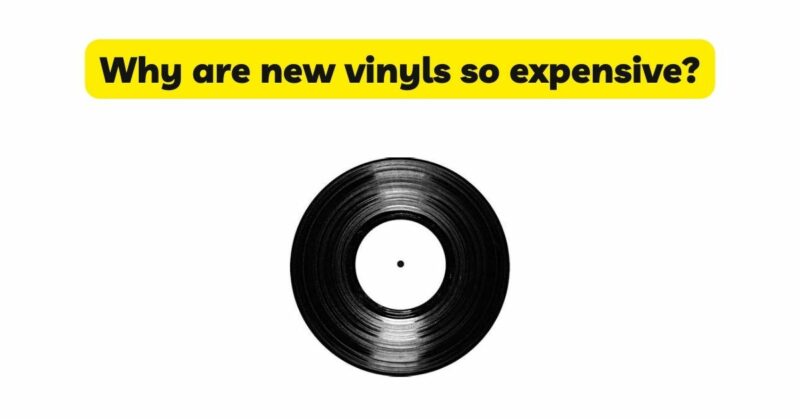The resurgence of vinyl records in recent years has delighted music enthusiasts with a tangible and immersive listening experience. However, one aspect that often raises questions is the relatively high price of new vinyl records compared to other music formats. In this article, we will explore the various factors contributing to the expense of new vinyl records, including manufacturing costs, limited production capacity, premium materials, demand and market trends, and the value placed on the vinyl experience.
- Manufacturing Costs: The production process of vinyl records involves numerous intricate and labor-intensive steps, which contribute to their higher cost. Unlike digital formats that can be easily duplicated and distributed at a low cost, vinyl production requires specialized equipment, skilled labor, and quality control measures. From mastering the audio to creating the metal stampers and operating the pressing machines, the manufacturing of vinyl records involves meticulous precision. These factors collectively increase the manufacturing costs associated with new vinyl records.
- Limited Production Capacity: One of the key factors affecting the price of new vinyl records is the limited production capacity. Despite the growing demand for vinyl, the number of pressing plants has not significantly expanded. This scarcity creates a supply-demand imbalance, with record labels and independent artists vying for limited manufacturing slots. The limited production capacity increases the cost of vinyl records, especially for smaller releases or independent artists with lower production runs.
- Premium Materials and Packaging: Many new vinyl releases feature premium materials and elaborate packaging, contributing to their higher price point. Record labels and artists often prioritize the aesthetic and tactile experience of vinyl, resulting in the use of high-quality materials such as heavyweight vinyl, gatefold sleeves, and additional inserts. These design choices enhance the value and collectability of the vinyl release but also increase the overall cost of production, which is then passed on to the consumer.
- Quality Control and Audiophile Editions: Some new vinyl releases cater to the discerning audiophile audience who seek the highest sound quality. These releases often undergo additional quality control measures, meticulous mastering, and the use of premium vinyl compounds. Audiophile editions are manufactured to meet the highest standards of sound reproduction, leading to enhanced sonic fidelity. The attention to detail and additional resources dedicated to achieving exceptional sound quality contribute to the higher price tag associated with these editions.
- Market Demand and Consumer Expectations: The increased demand for vinyl records, combined with the perceived value of the vinyl experience, influences the pricing strategy adopted by record labels. The market demand and consumer expectations play a significant role in determining the price of new vinyl records. Vinyl enthusiasts place a premium on the tangible and immersive nature of vinyl, valuing the larger album artwork, the tactile experience of handling the record, and the nostalgic connection to music. The willingness of consumers to pay a higher price for vinyl records reflects the demand for this unique music format.
- Rarity and Collectibility: Certain vinyl releases are considered rare or collectible due to limited availability or unique features. Limited edition releases, special variants, or exclusive pressings often command higher prices in the market. The scarcity and desirability of these records contribute to their higher cost. Additionally, albums from popular or influential artists, as well as releases from niche genres or underground scenes, may be highly sought after by collectors, further driving up the price of new vinyl records.
- Economics of Scale: Vinyl production operates on economies of scale, meaning that larger production runs tend to lower the cost per unit. Smaller releases or limited editions with smaller production runs often have higher unit costs due to the absence of economies of scale. Independent artists or smaller labels may have higher production costs compared to larger, established labels, further contributing to the higher prices of some new vinyl releases.
- Value of the Vinyl Experience: The vinyl experience encompasses more than just the music itself. Vinyl enthusiasts value the tangible and immersive nature of the format, the larger album artwork, the ritual of handling and playing records, and the collectability factor. The perceived value of the vinyl experience influences consumers’ willingness to pay a higher price for vinyl records, as they see it as an investment in a unique and rewarding way of enjoying music.
Conclusion: The relatively high price of new vinyl records can be attributed to various factors, including manufacturing costs, limited production capacity, premium materials, market demand, and the value placed on the vinyl experience. These factors collectively contribute to the overall expense of new vinyl releases. Despite the higher price tag, the tangible and immersive experience of vinyl, along with the superior sound quality and collectability, continues to attract music enthusiasts. New vinyl records have secured their place as a valuable and cherished music format, captivating a wide range of listeners and collectors who appreciate the unique attributes that vinyl offers.

